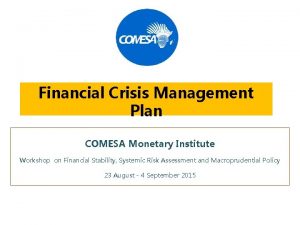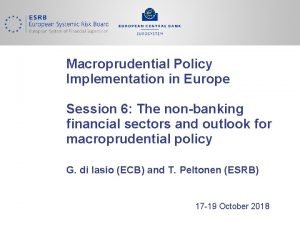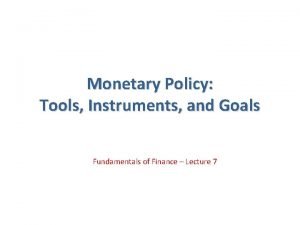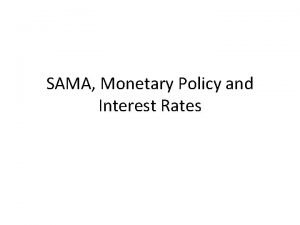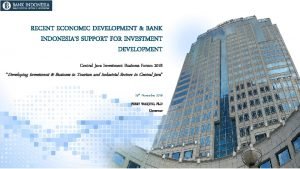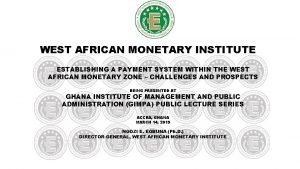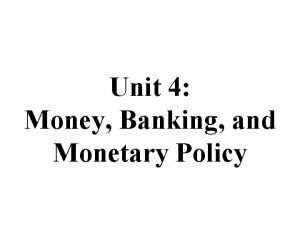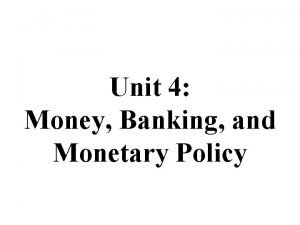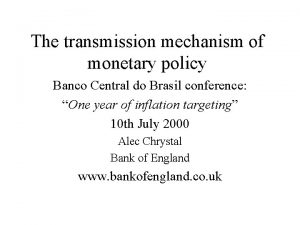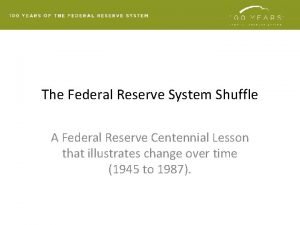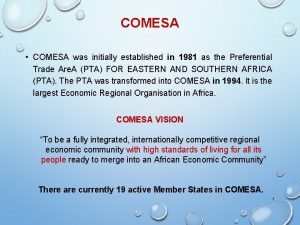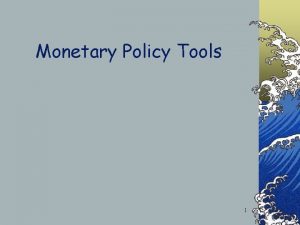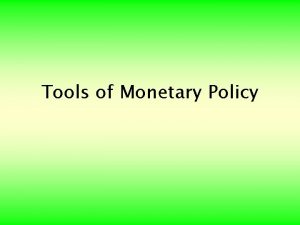COMESA MONETARY INSTITUTE TRAINING ON MACROPRUDENTIAL POLICY TOOLS












- Slides: 12

COMESA MONETARY INSTITUTE TRAINING ON MACROPRUDENTIAL POLICY TOOLS RELEVANT FOR COMESA MEMBER COUNTRIES WORKSHOP III: NETWORK ANALYSIS USING BANK-LEVEL DATA SOLUTIONS

QUESTION 2 • Which bank(s) would, in case of default, cause the greatest capital losses to the banking system as a whole? • Bank V’s overall exposure amounts to 4. 9 percent of the banking system’s core capital. • Bank V is currently borrowing from 10 banks.

QUESTION 3 • Which bank(s) is most vulnerable to a systemic event through contagion? Justify your answer. • • Bank N has lent out 86. 8 percent of its core capital. In questions 2 and 3, we observe the changes in interbank activity as a percentage of banks’ core capital because banks are expected to hold adequate highquality capital in order to absorb different types of shocks, including contagion shocks.

QUESTION 6 • Construct the interbank network as at the end of September 2014. The network MUST be weighted and directed, in a circle layout, with all the nodes clearly marked.

QUESTION 7 • Compute the following measures for this interbank market’s connectivity: Number of edges, network density, average path length, network diameter. Measure Network edges Value 78 Network density 0. 14 Average path length 1. 84 Network diameter 3

QUESTION 8 • Identify the most “central” banks in the network using the following measures: degree centrality, betweenness centrality, node strength (in-strength and out-strength). Measure Bank Value Degree H 17 Betweenness C 195. 750 In-strength V 80 Out-strength H 70. 5

QUESTION 9(A) • Bank H has the highest degree centrality with 17 outstanding transactions, 7 borrowing and 10 lending. • Bank H was also the strongest lender with 70. 5 due from 10 banks. • BANK C registered the highest betweenness centrality, an indication that this bank was part of many paths that connect other banks to each other, and had informational or relational importance within the network since it was vital in connecting banks to each other. • Bank V was the strongest borrower with 80 due to 10 banks.

QUESTION 9(A) • The centrality measures considered assist in identifying the banks that play an integral part in the proper functioning of the interbank market. • For instance, the degree and betweenness centralities identify those banks that are most central to the interbank network and thus facilitate the efficient spread of liquidity in the market. • In addition, banks’ strength, borrowing or lending, reveals the extent of their exposures and the potential impact their withdrawal from the market would have on the functioning of the market. • Therefore, it can be concluded from these measures that the key players in this interbank market were Banks C, H and V. • The network revealed the importance of Bank C not only in the first degree (direct) links but also in the multiple-degree (indirect) links that connect any given pair of banks, meaning that it had the highest level of connectivity in the network and, through its centrality measures, displayed its importance in connecting other banks in the network and facilitating the efficient spread of liquidity within the interbank market; • Bank H’s role in the interbank market is that of a liquidity provider.

QUESTION 9(B) • The interbank network appears to be incomplete since all banks have at least one transaction with another bank in the network. • A network density of 14 percent suggests that there is room for more connectivity and may also be an indicator of low market activity. • The distance measures, path length and diameter, are relatively small, an indication that the connectivity within the market facilitates effective access to short-term funding. • Measures of cohesion are best observed as changing over time. • • On the one hand, increased completeness of the network has led to increased market efficiency regarding distribution of funding. On the other hand, increased connectivity may increase the sector’s vulnerability to contagion risk as a sudden shock would be transmitted through fewer banks.

QUESTION 11 Measure Network edges Value 35 Network density 0. 08 Average path length 2. 06 Network diameter 4

QUESTION 12 • The total shortfall in core capital caused by the exclusion of the three key banks is 280. 4 (21. 8 percent). • Bank U is most affected by the exclusion of the most central banks • All its capital is depleted. • Exposure with both Banks H and V.

QUESTION 13 • It appears that this banking system holds enough capital to withstand the first round effects of a contagion shock. • The interbank network graphs and measures imply that although the network is incomplete, it is well connected since most banks have exposure to one or more banks. • Note: • • Interconnectedness is a double edged sword. The cohesion between banks that is beneficial in normal times can lead to contagion during stressed periods. Nevertheless, a certain level of network density must be maintained in order to guard against the impact of contagion risk; while high density increases the network’s vulnerability to shocks, allowing them to spread through network faster, it is possible that depending on banks’ capital levels, the impact of the shock would be quickly absorbed.
 Comesa monetary institute
Comesa monetary institute Macroprudential policy
Macroprudential policy Macroprudential policy
Macroprudential policy Three tools of monetary policy
Three tools of monetary policy Tools of monetary policy ppt
Tools of monetary policy ppt Macroprudential intermediation ratio
Macroprudential intermediation ratio West african monetary institute
West african monetary institute Unit 4 money banking and monetary policy
Unit 4 money banking and monetary policy Unit 4 money banking and monetary policy
Unit 4 money banking and monetary policy Transmission mechanism
Transmission mechanism Lesson quiz 16-1 monetary policy
Lesson quiz 16-1 monetary policy Objectives of monetary policy
Objectives of monetary policy What is monetary policy
What is monetary policy
